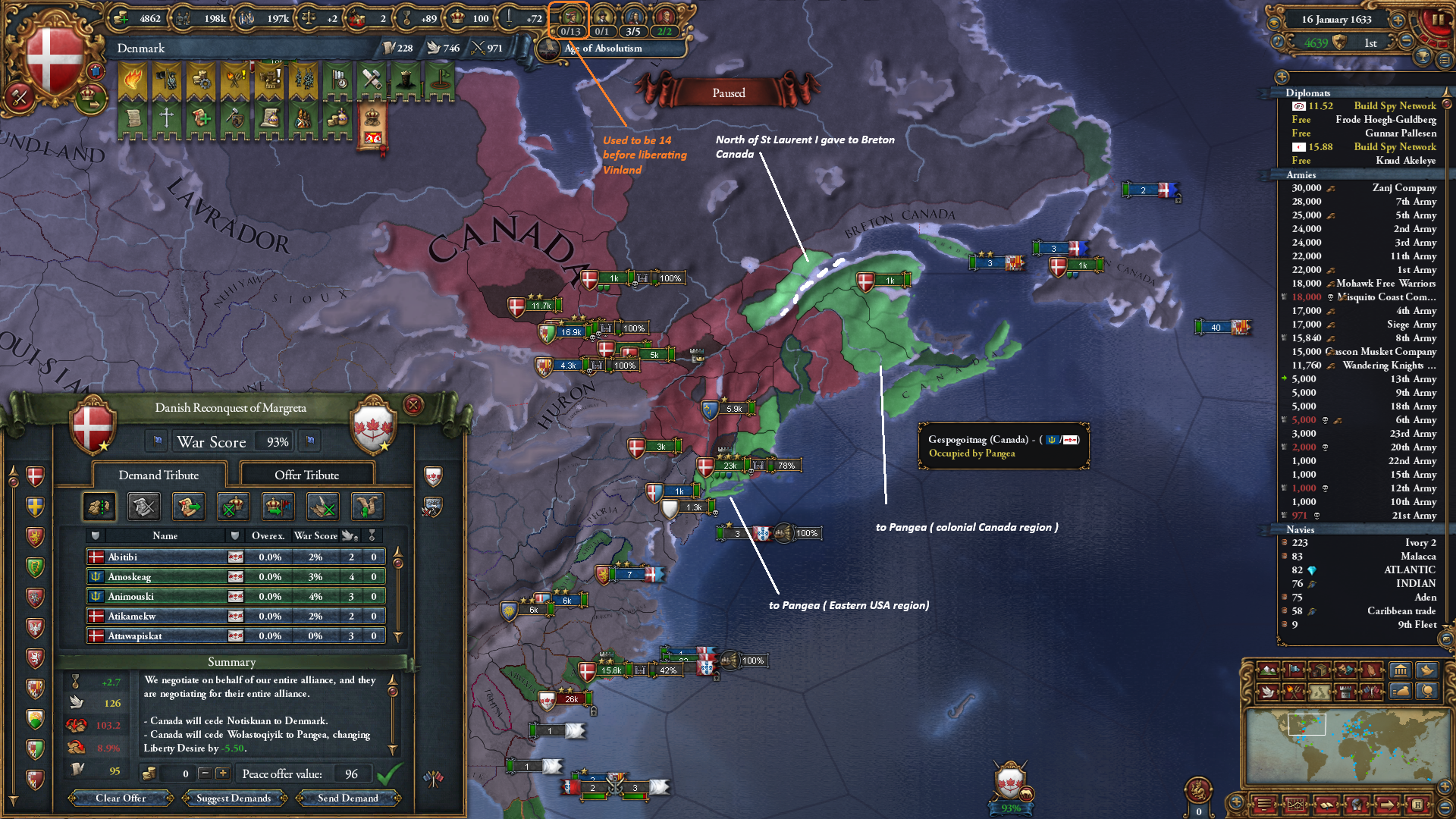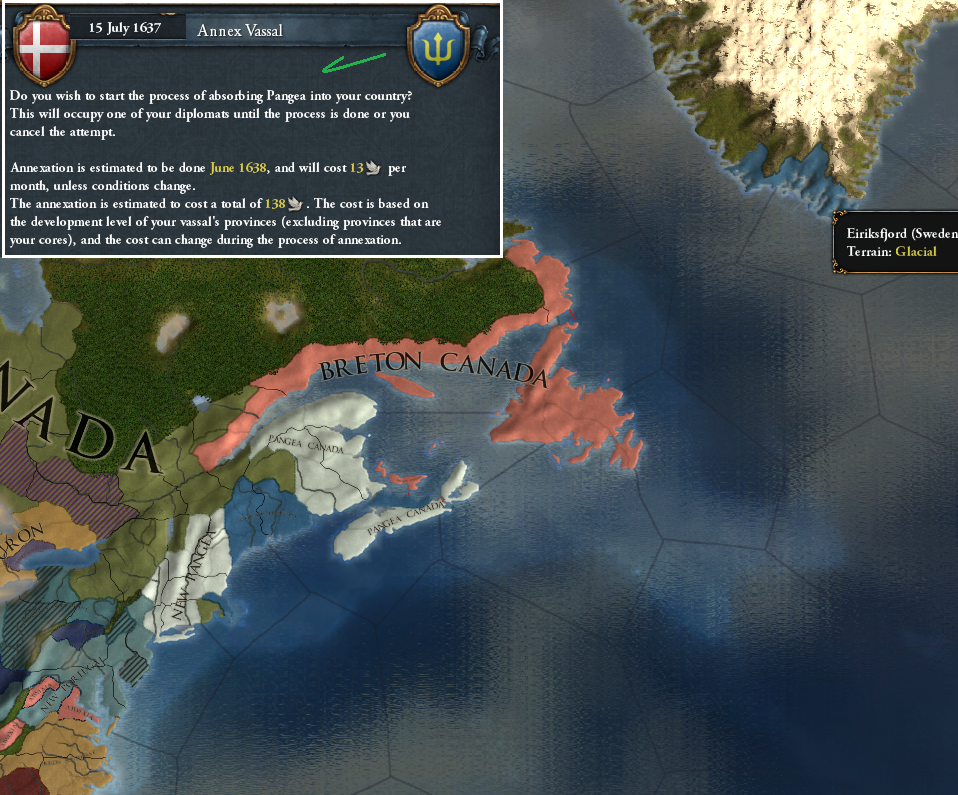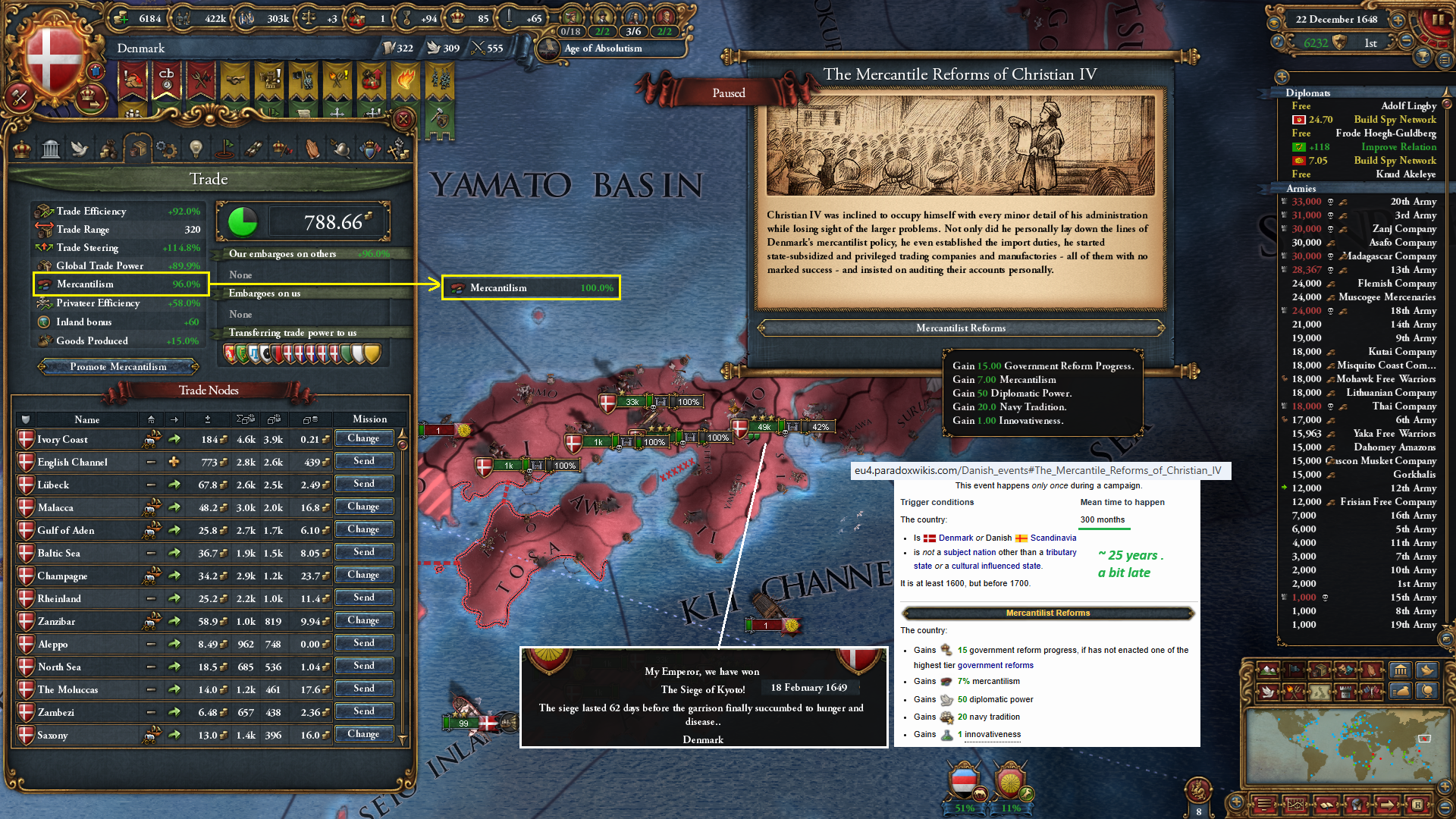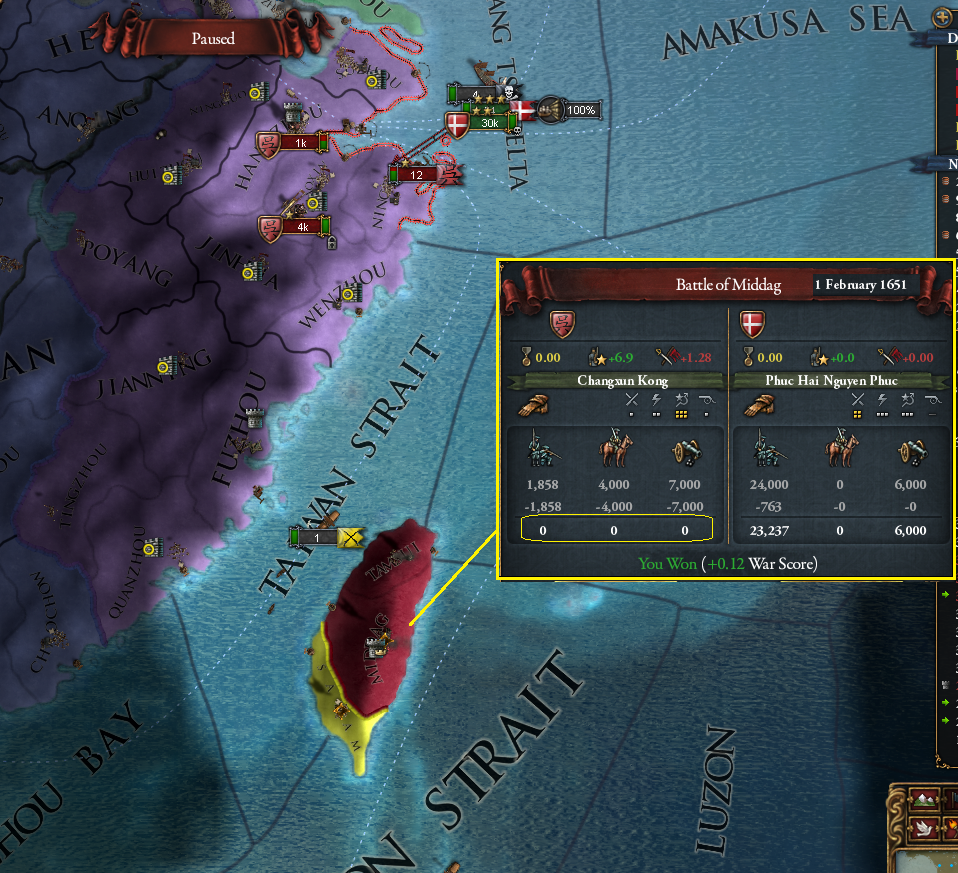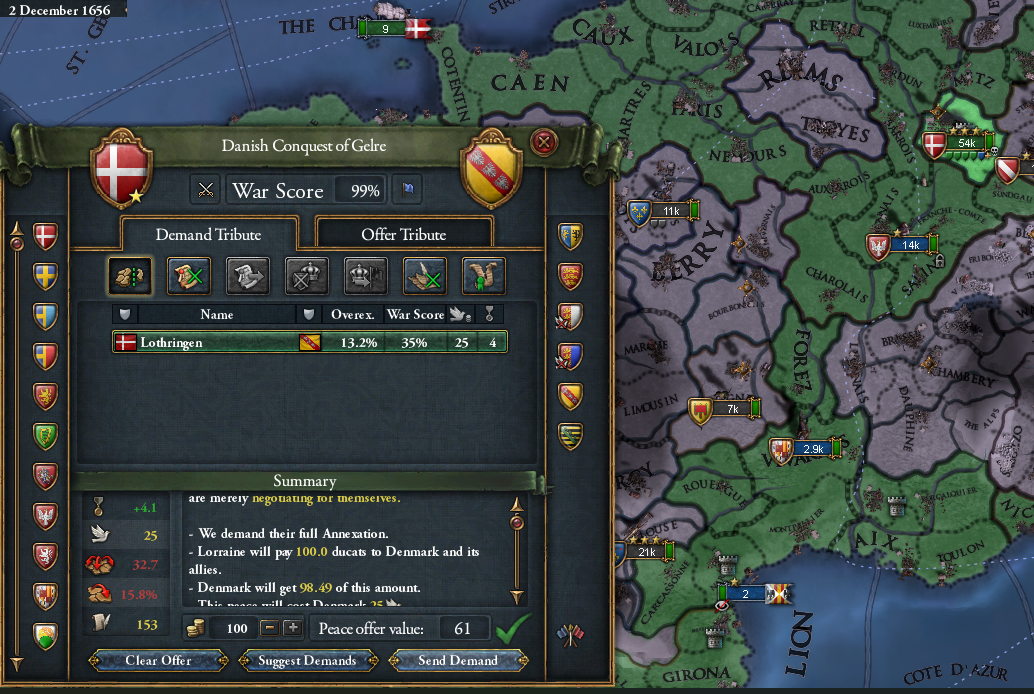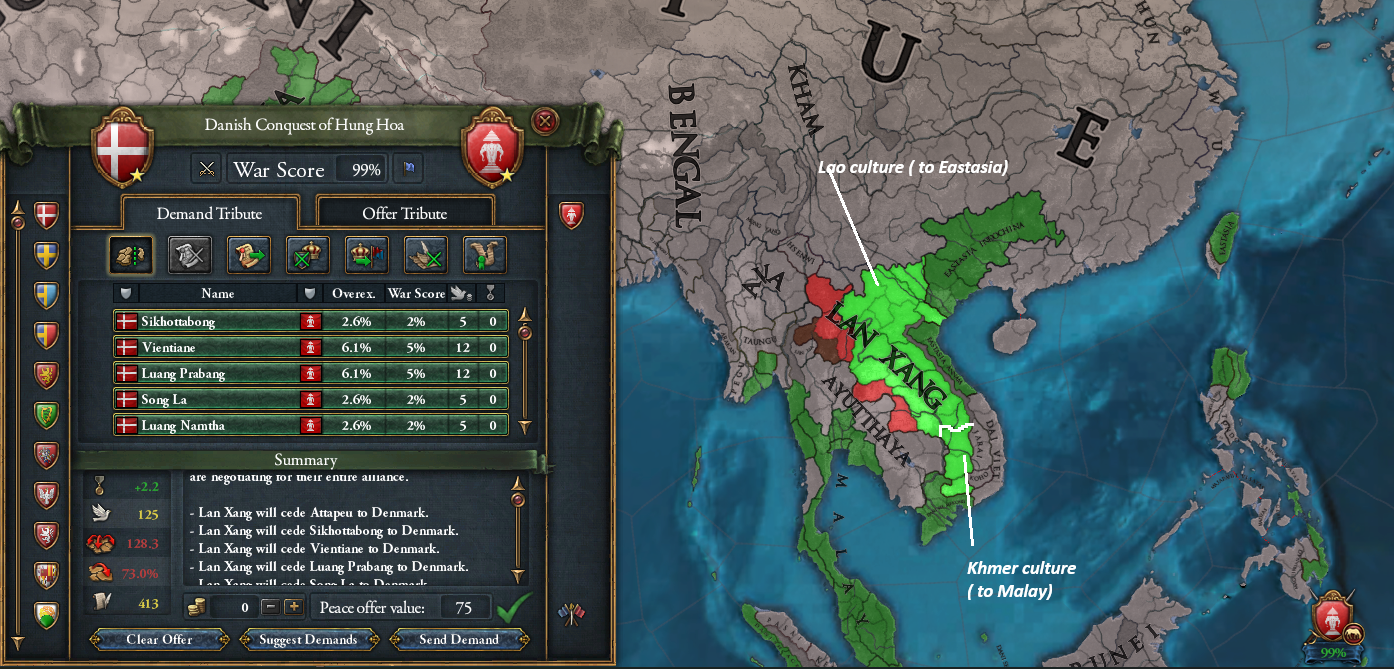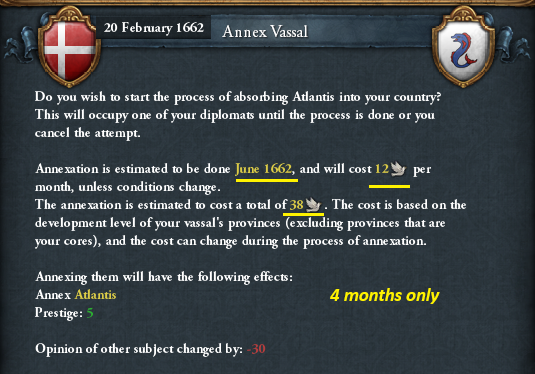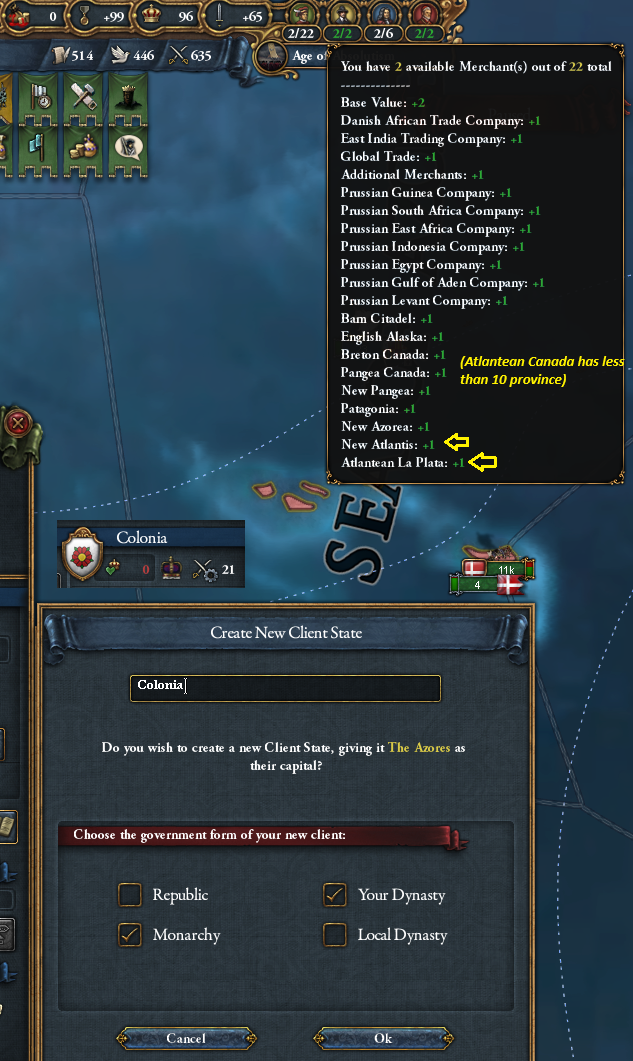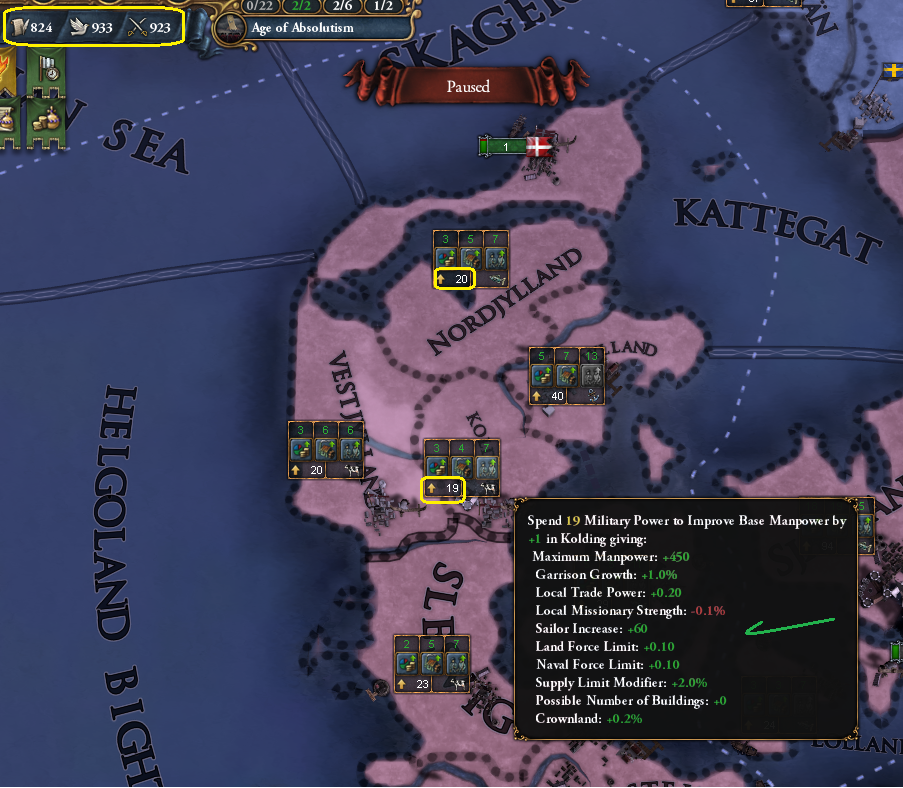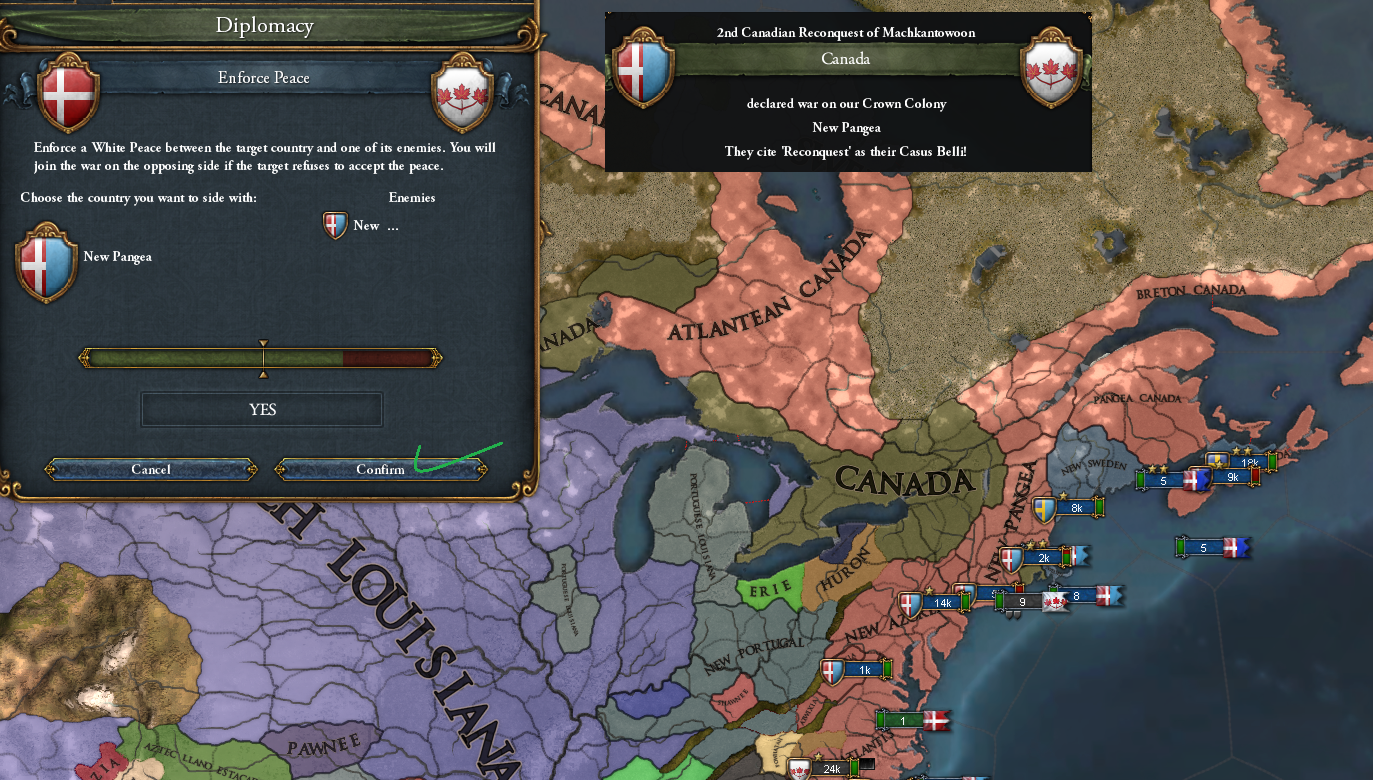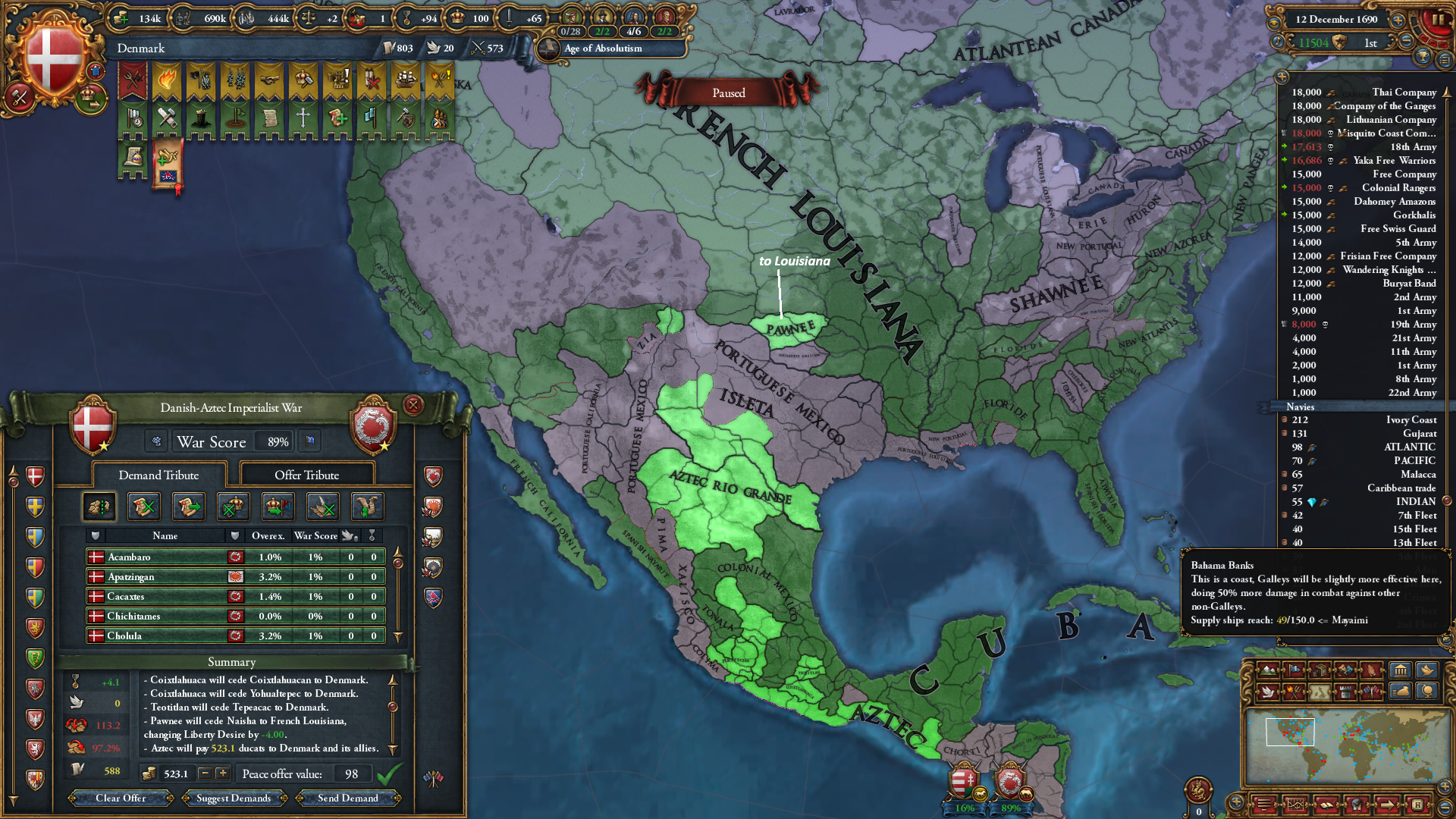Chapter 20: The Heresy of Niels Wittelsbach (1620-1630)
Prophetic words, as it turned out.
Starting with his unusual name, Niels Wittelsbach had always been a rule breaker. As a child he often disobeyed the rules of the Church , earning him the trait of Sinner at the age of 15. But his reputation as an iconoclast was really cemented in the tumultuous decade of the 1620s when he broke from the traditions of his predecessors and took many actions that did not make any sense to his contemporaries. Many thought the good Emperor was incompetent at best, or was actively sabotaging his father's legacy at worst . But before we get to those actions, we will take a peek at the plans of his father, Frederik the Impatient, whose archivist left a blueprint for the future of Denmark.

The map in Frederik's archives , drawn just before his untimely death in July 1619, had Europe split between Denmark , her 10 Personal Unions, and 4 direct vassals . Each culture group was represented by one subject generally, with a few like the British and Carpathian groups split among neighbors. With that map, nearly every province in Europe had a culture accepted by its ruler. That map was going to be the blueprint for the next few decades. And the archivist even had a title picked for the final chapter in the Saga, to be called "Ten Crowns To Bind Them" .
But then Frederik choked on his meal, and along came Niels and up-ended all that.
At first, Niels continued the policy of his father. He began the annexation of Brunswick ( who was placed on Scutage earlier for that purpose) in October 1620 and then concluded peace with Two Sicilies.


In the peace, he had Two Sicilies return cores to Sicily which improved relations with the new junior Union partner. And he also had Denmark give Sicily several provinces in the boot of Italy .
So far, so good. But then, instead of waiting for aggressive expansion with Saxony to decay like he discussed with his father's advisors in the last chapter, he promptly declared war for the Restoration of Union .

Saxony was allied to Wurttemberg. And Niels took advantage of that to make another surprising move
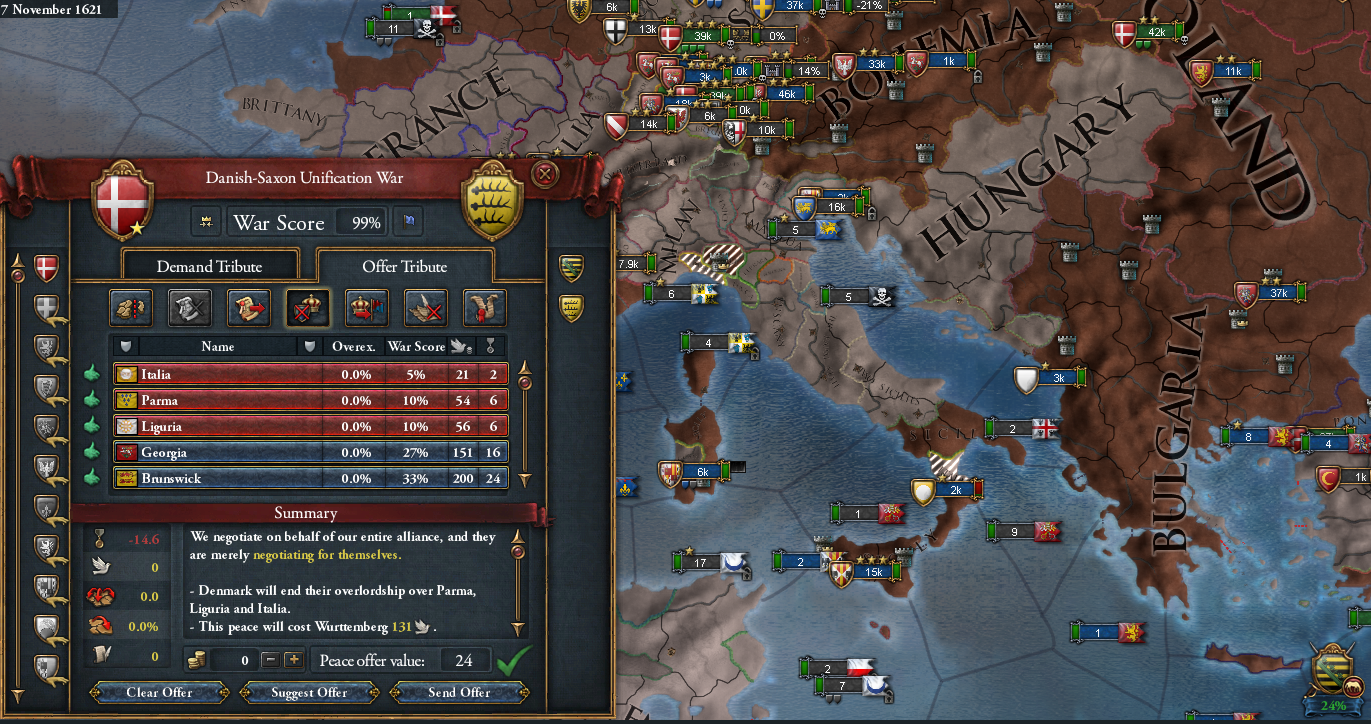
He pretended to lose the war to Wurttemberg and had them ratify the end of Denmark's overlordship over Italia, Liguria and Parma. His advisors had previously thought these tiny nations could be easily annexed into Denmark and then given to Sicily . But Niels apparently had other plans.
And then he really surprised his advisors when Denmark researched National Sovereignty in January 1622 and unlocked another idea group. And Niels chose.....Expansion Ideas.

( I guess @MatthewP was not one of the surprised advisors )
)
That generated howls of laughter from the people. "The entire world has already been colonized!" everyone said. French California and English Alaska were a thing already . Only a few desolate provinces here and there were left open. And Niels promptly chose one of the coldest and farthest away, and sent his colonist to Ahiarmut in Colonial Canada

A few months later, Saxony accepted peace terms, and returned to Denmark's fold

With Saxony a personal Union, Denmark now had 10 Personal unions, and Niels had finally achieved the dream of his fathers, the achievement of Atwix Legacy

But instead of celebrating that great milestone with pomp and circumstance, Niels did another seemingly crazy deed: he liberated Vinland

And he followed that with another harebrained decision: he voluntarily ended the personal union with Provence. His advisors were taken aback. Denmark was already in the process of annexing Gallia, with the plan to feed the Gallian provinces ( Burgundian culture) to the French culture subject Provence. But now Provence was free and therefore Denmark would own Burgundian land directly ( again!).

After that , Niels did something that finally made sense to his entourage. He declared war on England, with the aim of solidifying Danish control of the channel node

ANd he followed it with another war previously contemplated by his father. And that was against the Ottomans for reconquest of Georgia's cores.

Because of the simultaneous wars, the fighting was a bit tough for Denmark. But eventually the enemy belligerents began to be peaced one by one. Hungary was made to pay money and did not lose land. Mann, Strasbourg and Tirol were made to give up alliances to shore up Danish prestige lost from the release of the Italian minors ( some advisors wondered why places like Mann were not annexed, but others figured it was to keep Mann as a Prestige farm in the future). And finally Portugal, who put up a lot of fighting in the colonies, was made to give up land.

Denmark took just 3 provinces from Portugal (advisors wanted to continue the war and take more, but Niels told them "I have what I need") . One province , Cartagena in SOuth America, made sense . It was home to the Great Project of Cartagena De Las Indias which promised to enhance the trade power of Denmark's fleets. But the other two, Madeira and Azores, were tiny islands out in the Atlantic. But the advisors, now used to the eccentric Emperor, did not ask why those two and simply rolled their eyes. As for England herself, she was made to cede all her coastal provinces in Britain, as well as Boriken in the Caribbean and Epagoitgnag in Canada. That effectively turned England into a landlocked nation ( unless she had colonies that escaped detection)

This was followed by peace with the Ottomans

THe Turks were made to return Georgia's cores to her, enhancing her relation with Denmark. They were also made to cede a swath of land North of the Caucasus of Astrakhani culture, which was given to Georgia as well .
Denmark was now at peace again. And having gotten rid of the Italian minor vassals as well as Provence, and having annexed Brunswick ( and almost on the verge of annexing Gallia), she found herself with a luxury she has not enjoyed in a long time: she was under the diplomatic relations limit.

And the Emperor took advantage of that to create Denmark's newest subject, the Client State of Pangea , based out of Madeira and the Azores ( h/t @alonsom13 for the name). He chose that name to reflect his dream of a WorldWide Union, in whose formation the new Client State of Pangea was intended to play an important role.

And then he proclaimed his intention for Danish World Wide domination by proclaiming Denmark as the Naval Hegemon .

And to show the world he meant business, the newly proclaimed Hegemon declared war on the African nation of Benin, allied to Kongo.

That war turned out to be harder than anticipated because Kongo was militarily on par with Denmark [both tech 18]. And Denmark had to scramble some more mercenary companies to Africa to eventually win the war, but win she did. But while that fighting went on, we will note internal affairs, most important of which was the completion of Gallia's annexation and the promotion of BUrgundian to accepted culture status, using one of the few slots Denmark had left at that time.

ANd on the external front, the colony of Atwixia suffered back to back defeats at the hands of the natives and then the Canadians ( formerly Vinland). To which Niels, to the dismay of his advisors, responded with a shrug and jut the word "Good!" .

And like all other rulers, Niels had his share of good and bad events


Eventually the war with Benin and Kongo reached its conclusion with the enemies defeated completely. First Kongo was made to sign peace, losing only the Kongolese culture provinces to DEnmark, and one province to Pangea

Although Denmark could have taken more land, Emperor Niels insisted that only Kongolese land be taken , and that Pangea be given one province. His diplomats dutifully followed his wishes even though many of them did not understand why. He then had a similar peace signed with Benin and her ally

Again he limited gains by culture lines ( only Yoruba and Nupe culture land was annexed) and one province went to Pangea.
Once Denmark was at peace, he used up the last diplomatic slots available on two new nations: Nigeria, based out of Ife near the Niger River Delta, and Sudafrica, based out of Kongo's old capital of Mpemba

Both new capitals were purposely located inland, and not in the Ivory trade node to avoid having them compete with Denmark in the crucial node.
Then Emperor Niels declared he was going to expand Sudafrica by declaring war on France , allied to Kilwa

Denmark took advantage of the fact that many armies were already in Africa at the end of the Benin and Kongo war, so occupying Kilwa and French South Africa was easy. And France itself easily succumed to Denmark's onslaught assisted by her powerful personal unions in Europe. The decisive battle on that front was fought at Paris, where the French army almost defeated the combined mercenary companies of DEnmark, only to have a late arrival by the Saxon forces save the day for the Danes.

After that France and her allies were quickly overrun. But Emperor Neils did not get to enjoy the fruits of that victory. For on November 6, 1628 Niels II the "heretic" died of uknown causes.

He had reigned just shy of 10 years. But his brief reign was monumental in changing the direction of our history and the future of Denmark. As a result of his early death, Saxony broke away again from Denmark and became independent. And his capable wife, Dorothea 6/6/1 took over. Judging from her actions, she seemed to have been aware of his long term plans. For as soon as the colony at Ahiarmiut in Canada completed, she had the colonists dig up the famed Inukshuk monument and refurbished it to Noteworthy status , before shipping it off to Zeeland.

ANd thanks the additional accepted culture given by the monument, Francien was promoted to equal status with Denmark's all other accepted cultures (Denmark already owned Picardie, which was Francien) .
Soon after,more of Niels' plans were implemented by his widow as peace was made with Kilwa then France.

From Kilwa, Denmark took the Mutapa gold mines as well as nearby connecting provinces. The Mutapa lands were Shona culture while the others were Swahili cultures ( former colonies of KIlwa). From France , Denmark took the state of Ile De France with its 4 rich provinces , as well as all of French South Africa, along with a smattering of Francien culture colonies in the Atlantic ( Fernando Po and St Helena), Indian ocean (Hollahavai, Mauritius, Bourbon) and the Spice Islands ( Ceram and Halmahera). The South African annexation was then divvied up between Denmark - who kept the Francien provinces - and Sudafrica, who got the Ngeni, Shona and Swahili cultures.

The decade was almost over. But Niels' widow had time to start one last war , against former Junior Partner Provence.

Provence was allied to Gascony, and Denmark hoped to get land from both nations and give to her subjects Sicily and Spain . But that will be , God-Willing, in the next chapter.
We end with Denmark's dominion, drastically changed in the short reign of Niels II v Wittelsbach.




FOOTNOTES:
I normally explain my thought process in the narrative, but I avoided that in this chapter to maintain the narrative of Niels Wittelsbach doing unusual things. So here are teh explanations in gamespeak for some of those actions :
1. Declare on Saxony early - get Atwix achievement out of way , because I knew I will be releasing Provence to cull the number of PUs.
2. free the tiny Italian vassals instead of annexing them - save DIP slots and diplo points . Sicily will conquer later, after it was fed South France . we do not want sicily to waste culture acceptance slots on same group cultures.
3 . liberate Vinland - I war worried that the moment I get Ahiarwiut completed , Vinland takes the proince and I will not be able to move the monument. So I played it safe and let them go. Also, abandoning Vinland will let me get more CNs later on in same colonial region
.
4 . free Provence. DEnmark already accepted Walloon and Norman . Add Burgundian and Francien, and that leaves only 3 French cultures not accepted (Breton, Gascon, Occitan). Those are better split among other subjects instead of wasting a slot on a French culture subject. Now I could have integrated Provence, but why pay DIP to then give it to my vassal, instead of conquering and have vassal spend ADM to core it.
5. Expansion ideas. @MatthewP guessed correctly. It is to lower LD via policies.
6.why Azores and Madiera. THey are in Europe, so I can create a Client State. Importantly , Madeira was in coring range ( 525 colonial ) to the Benin province ( I measured by loading up a new game and creating a custom nation in Madeira, then using colonial map to Estimate). And Azores is in coring range to the New World. I hope to use that feature in later chapters.
7. Why not take more land from Portugal? Besides being a non co-belligerent , I do not want to give Spain more portuguese land so they do not waste their next culture slot on Portugal, instead of spending it on Gascony.
8 why client states and not regular subjects? More loyal, will have Humanist ideas so more culture spots. Religion could allow to turn them into PUs if keeping them in line becomes harder.
7 Atwixia losing land - A lot of unaccepted cultures in America with Atwixia. Starting fresh with new nations in the Eastern USA ( by feeding Europe based vassals land) will give more merchants and more cultural homogeneity
8. WHy annexed only Kongolese land from Kongo, only Yoruba+Nupe land from Benin? Since I want to have as much culturally accepted provinces in the world, and I cannot have an infinite number of vassals, I need to maximize the culture acceptance slots they have. The best way to do that is create the vassal in a culture group with many small cultures, but restrict them to just one culture in the group. Then expand that vassal into a neighboring group with bigger but fewer cultures. Once all the acceptance slots are full with neighbor culture, we can feed the vassal the same group cultures. This way AI does not waste slots on same group cultures ( like Spain did with Catalan, Leonese etc) . I began to implement this in case of Sudafrica by growing them into neighboring groups ( Shona, Swahili, Nguni) .
9 why one province to Pangea from Benin and Kongo ? This is a workaround to being unable to create client states in other continents. Since you can create a client state next to an existing one, I just "seeded" the Benin area with a single Pangea province ( via transfer occupation) . That allowed creation of Nigeria. Similiary in Kongo region for Sudafrica. Going forward , I can similarly use Sudafrica to seed a client state in say, Arabia or India ( once they have coring range there) .
As for Niels - heresy!
Prophetic words, as it turned out.
Starting with his unusual name, Niels Wittelsbach had always been a rule breaker. As a child he often disobeyed the rules of the Church , earning him the trait of Sinner at the age of 15. But his reputation as an iconoclast was really cemented in the tumultuous decade of the 1620s when he broke from the traditions of his predecessors and took many actions that did not make any sense to his contemporaries. Many thought the good Emperor was incompetent at best, or was actively sabotaging his father's legacy at worst . But before we get to those actions, we will take a peek at the plans of his father, Frederik the Impatient, whose archivist left a blueprint for the future of Denmark.

The map in Frederik's archives , drawn just before his untimely death in July 1619, had Europe split between Denmark , her 10 Personal Unions, and 4 direct vassals . Each culture group was represented by one subject generally, with a few like the British and Carpathian groups split among neighbors. With that map, nearly every province in Europe had a culture accepted by its ruler. That map was going to be the blueprint for the next few decades. And the archivist even had a title picked for the final chapter in the Saga, to be called "Ten Crowns To Bind Them" .
But then Frederik choked on his meal, and along came Niels and up-ended all that.
At first, Niels continued the policy of his father. He began the annexation of Brunswick ( who was placed on Scutage earlier for that purpose) in October 1620 and then concluded peace with Two Sicilies.


In the peace, he had Two Sicilies return cores to Sicily which improved relations with the new junior Union partner. And he also had Denmark give Sicily several provinces in the boot of Italy .
So far, so good. But then, instead of waiting for aggressive expansion with Saxony to decay like he discussed with his father's advisors in the last chapter, he promptly declared war for the Restoration of Union .

Saxony was allied to Wurttemberg. And Niels took advantage of that to make another surprising move

He pretended to lose the war to Wurttemberg and had them ratify the end of Denmark's overlordship over Italia, Liguria and Parma. His advisors had previously thought these tiny nations could be easily annexed into Denmark and then given to Sicily . But Niels apparently had other plans.
And then he really surprised his advisors when Denmark researched National Sovereignty in January 1622 and unlocked another idea group. And Niels chose.....Expansion Ideas.

( I guess @MatthewP was not one of the surprised advisors
That generated howls of laughter from the people. "The entire world has already been colonized!" everyone said. French California and English Alaska were a thing already . Only a few desolate provinces here and there were left open. And Niels promptly chose one of the coldest and farthest away, and sent his colonist to Ahiarmut in Colonial Canada

A few months later, Saxony accepted peace terms, and returned to Denmark's fold

With Saxony a personal Union, Denmark now had 10 Personal unions, and Niels had finally achieved the dream of his fathers, the achievement of Atwix Legacy

But instead of celebrating that great milestone with pomp and circumstance, Niels did another seemingly crazy deed: he liberated Vinland

And he followed that with another harebrained decision: he voluntarily ended the personal union with Provence. His advisors were taken aback. Denmark was already in the process of annexing Gallia, with the plan to feed the Gallian provinces ( Burgundian culture) to the French culture subject Provence. But now Provence was free and therefore Denmark would own Burgundian land directly ( again!).

After that , Niels did something that finally made sense to his entourage. He declared war on England, with the aim of solidifying Danish control of the channel node

ANd he followed it with another war previously contemplated by his father. And that was against the Ottomans for reconquest of Georgia's cores.

Because of the simultaneous wars, the fighting was a bit tough for Denmark. But eventually the enemy belligerents began to be peaced one by one. Hungary was made to pay money and did not lose land. Mann, Strasbourg and Tirol were made to give up alliances to shore up Danish prestige lost from the release of the Italian minors ( some advisors wondered why places like Mann were not annexed, but others figured it was to keep Mann as a Prestige farm in the future). And finally Portugal, who put up a lot of fighting in the colonies, was made to give up land.

Denmark took just 3 provinces from Portugal (advisors wanted to continue the war and take more, but Niels told them "I have what I need") . One province , Cartagena in SOuth America, made sense . It was home to the Great Project of Cartagena De Las Indias which promised to enhance the trade power of Denmark's fleets. But the other two, Madeira and Azores, were tiny islands out in the Atlantic. But the advisors, now used to the eccentric Emperor, did not ask why those two and simply rolled their eyes. As for England herself, she was made to cede all her coastal provinces in Britain, as well as Boriken in the Caribbean and Epagoitgnag in Canada. That effectively turned England into a landlocked nation ( unless she had colonies that escaped detection)

This was followed by peace with the Ottomans

THe Turks were made to return Georgia's cores to her, enhancing her relation with Denmark. They were also made to cede a swath of land North of the Caucasus of Astrakhani culture, which was given to Georgia as well .
Denmark was now at peace again. And having gotten rid of the Italian minor vassals as well as Provence, and having annexed Brunswick ( and almost on the verge of annexing Gallia), she found herself with a luxury she has not enjoyed in a long time: she was under the diplomatic relations limit.

And the Emperor took advantage of that to create Denmark's newest subject, the Client State of Pangea , based out of Madeira and the Azores ( h/t @alonsom13 for the name). He chose that name to reflect his dream of a WorldWide Union, in whose formation the new Client State of Pangea was intended to play an important role.

And then he proclaimed his intention for Danish World Wide domination by proclaiming Denmark as the Naval Hegemon .

And to show the world he meant business, the newly proclaimed Hegemon declared war on the African nation of Benin, allied to Kongo.

That war turned out to be harder than anticipated because Kongo was militarily on par with Denmark [both tech 18]. And Denmark had to scramble some more mercenary companies to Africa to eventually win the war, but win she did. But while that fighting went on, we will note internal affairs, most important of which was the completion of Gallia's annexation and the promotion of BUrgundian to accepted culture status, using one of the few slots Denmark had left at that time.

ANd on the external front, the colony of Atwixia suffered back to back defeats at the hands of the natives and then the Canadians ( formerly Vinland). To which Niels, to the dismay of his advisors, responded with a shrug and jut the word "Good!" .

And like all other rulers, Niels had his share of good and bad events


Eventually the war with Benin and Kongo reached its conclusion with the enemies defeated completely. First Kongo was made to sign peace, losing only the Kongolese culture provinces to DEnmark, and one province to Pangea

Although Denmark could have taken more land, Emperor Niels insisted that only Kongolese land be taken , and that Pangea be given one province. His diplomats dutifully followed his wishes even though many of them did not understand why. He then had a similar peace signed with Benin and her ally

Again he limited gains by culture lines ( only Yoruba and Nupe culture land was annexed) and one province went to Pangea.
Once Denmark was at peace, he used up the last diplomatic slots available on two new nations: Nigeria, based out of Ife near the Niger River Delta, and Sudafrica, based out of Kongo's old capital of Mpemba

Both new capitals were purposely located inland, and not in the Ivory trade node to avoid having them compete with Denmark in the crucial node.
Then Emperor Niels declared he was going to expand Sudafrica by declaring war on France , allied to Kilwa

Denmark took advantage of the fact that many armies were already in Africa at the end of the Benin and Kongo war, so occupying Kilwa and French South Africa was easy. And France itself easily succumed to Denmark's onslaught assisted by her powerful personal unions in Europe. The decisive battle on that front was fought at Paris, where the French army almost defeated the combined mercenary companies of DEnmark, only to have a late arrival by the Saxon forces save the day for the Danes.

After that France and her allies were quickly overrun. But Emperor Neils did not get to enjoy the fruits of that victory. For on November 6, 1628 Niels II the "heretic" died of uknown causes.

He had reigned just shy of 10 years. But his brief reign was monumental in changing the direction of our history and the future of Denmark. As a result of his early death, Saxony broke away again from Denmark and became independent. And his capable wife, Dorothea 6/6/1 took over. Judging from her actions, she seemed to have been aware of his long term plans. For as soon as the colony at Ahiarmiut in Canada completed, she had the colonists dig up the famed Inukshuk monument and refurbished it to Noteworthy status , before shipping it off to Zeeland.

ANd thanks the additional accepted culture given by the monument, Francien was promoted to equal status with Denmark's all other accepted cultures (Denmark already owned Picardie, which was Francien) .
Soon after,more of Niels' plans were implemented by his widow as peace was made with Kilwa then France.

From Kilwa, Denmark took the Mutapa gold mines as well as nearby connecting provinces. The Mutapa lands were Shona culture while the others were Swahili cultures ( former colonies of KIlwa). From France , Denmark took the state of Ile De France with its 4 rich provinces , as well as all of French South Africa, along with a smattering of Francien culture colonies in the Atlantic ( Fernando Po and St Helena), Indian ocean (Hollahavai, Mauritius, Bourbon) and the Spice Islands ( Ceram and Halmahera). The South African annexation was then divvied up between Denmark - who kept the Francien provinces - and Sudafrica, who got the Ngeni, Shona and Swahili cultures.

The decade was almost over. But Niels' widow had time to start one last war , against former Junior Partner Provence.

Provence was allied to Gascony, and Denmark hoped to get land from both nations and give to her subjects Sicily and Spain . But that will be , God-Willing, in the next chapter.
We end with Denmark's dominion, drastically changed in the short reign of Niels II v Wittelsbach.




FOOTNOTES:
I normally explain my thought process in the narrative, but I avoided that in this chapter to maintain the narrative of Niels Wittelsbach doing unusual things. So here are teh explanations in gamespeak for some of those actions :
1. Declare on Saxony early - get Atwix achievement out of way , because I knew I will be releasing Provence to cull the number of PUs.
2. free the tiny Italian vassals instead of annexing them - save DIP slots and diplo points . Sicily will conquer later, after it was fed South France . we do not want sicily to waste culture acceptance slots on same group cultures.
3 . liberate Vinland - I war worried that the moment I get Ahiarwiut completed , Vinland takes the proince and I will not be able to move the monument. So I played it safe and let them go. Also, abandoning Vinland will let me get more CNs later on in same colonial region
.
4 . free Provence. DEnmark already accepted Walloon and Norman . Add Burgundian and Francien, and that leaves only 3 French cultures not accepted (Breton, Gascon, Occitan). Those are better split among other subjects instead of wasting a slot on a French culture subject. Now I could have integrated Provence, but why pay DIP to then give it to my vassal, instead of conquering and have vassal spend ADM to core it.
5. Expansion ideas. @MatthewP guessed correctly. It is to lower LD via policies.
6.why Azores and Madiera. THey are in Europe, so I can create a Client State. Importantly , Madeira was in coring range ( 525 colonial ) to the Benin province ( I measured by loading up a new game and creating a custom nation in Madeira, then using colonial map to Estimate). And Azores is in coring range to the New World. I hope to use that feature in later chapters.
7. Why not take more land from Portugal? Besides being a non co-belligerent , I do not want to give Spain more portuguese land so they do not waste their next culture slot on Portugal, instead of spending it on Gascony.
8 why client states and not regular subjects? More loyal, will have Humanist ideas so more culture spots. Religion could allow to turn them into PUs if keeping them in line becomes harder.
7 Atwixia losing land - A lot of unaccepted cultures in America with Atwixia. Starting fresh with new nations in the Eastern USA ( by feeding Europe based vassals land) will give more merchants and more cultural homogeneity
8. WHy annexed only Kongolese land from Kongo, only Yoruba+Nupe land from Benin? Since I want to have as much culturally accepted provinces in the world, and I cannot have an infinite number of vassals, I need to maximize the culture acceptance slots they have. The best way to do that is create the vassal in a culture group with many small cultures, but restrict them to just one culture in the group. Then expand that vassal into a neighboring group with bigger but fewer cultures. Once all the acceptance slots are full with neighbor culture, we can feed the vassal the same group cultures. This way AI does not waste slots on same group cultures ( like Spain did with Catalan, Leonese etc) . I began to implement this in case of Sudafrica by growing them into neighboring groups ( Shona, Swahili, Nguni) .
9 why one province to Pangea from Benin and Kongo ? This is a workaround to being unable to create client states in other continents. Since you can create a client state next to an existing one, I just "seeded" the Benin area with a single Pangea province ( via transfer occupation) . That allowed creation of Nigeria. Similiary in Kongo region for Sudafrica. Going forward , I can similarly use Sudafrica to seed a client state in say, Arabia or India ( once they have coring range there) .
- 1








